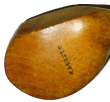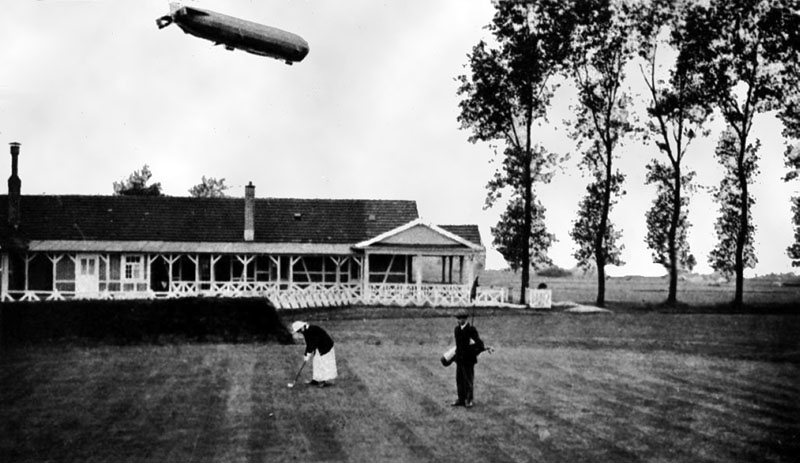
|
Registration Edit profile catalogue auction shopping cart shipping history makers search faq news links about contact |

Scottish Golf History
PlacesBaden-Baden(Source: © 2014, Douglas MacKenzie) I do not pretend Baden-Baden played a pivotal role in Scottish golf or clubmaking. In fact, it plays none at all. This is just another occasion when there is a photograph too good to pass up for an article ! Sadly, it also provides a tangential illustration of golf, like anything else, being seen as fair game for jingoism, all the more pertinent with what will be said this year to ‘commemorate’ the centenary of the First World War. Although Baden-Baden is not the oldest golf club in Germany (the third oldest, in fact, being founded in 1901) it did do something that put Germany on the golfing map back in 1911 and was, as The American Golfer magazine expressed it at the time ‘the first golfing event that has ever taken place in Germany that has attracted any general attention at all'. The Deutscher Golf Verband, an association comprising the first eight clubs formed in Germany, was founded in Hamburg in 1907 but as a 1914 article in Golf Illustrated noted, ‘a few years ago an Englishman won the championship of Germany at Homburg, using only a mashie and a putter’ it didn’t really set the Heide on fire. The Baden-Baden club set out to change this. Having made some improvements to the course and clubhouse they issued invitations for a tournament in 1911 which they called the Championship of Germany. The DGV took severe exception to this ‘being apparently much jealous of the great enterprise of the people of Baden-Baden’ (The American Golfer again) and a compromise was reached by which the tournament was called the Open Championship of Baden-Baden. And a fine tournament it was. Some of the best British professionals contested the four rounds of strokeplay for the $1250 prize money and the $500 first prize was won by Harry Vardon with an incredible score of 279. ‘Easy’ course or not, a sub 70 average over four rounds was unheard of, and was nine strokes better than Sandy Herd in second place and eighteen better than Ted Ray. Given the perceived success of this event, they decided to up the stakes the following year. Prize money would be doubled with $650 going to the winner and $400 to the runner up with the entrance fee of five dollars being refunded to all those who actually turned up. Furthermore ‘all contestants are provided by the town of Baden-Baden with their hotel accommodation and meals free of cost’ and as The American Golfer pointed out to those unfamiliar with the charms of the famous spa, 'Baden-Baden is something of a fashionable society resort, and is not by any means a common or a cheap place'. To avoid any grumbling from the DGV about the use of the name German Open Championship they stuck with the name and withdrew from the association. That second Open attracted almost eighty professionals. Vardon, Taylor and Sandy Herd (James Braid had a prior engagement which probably meant he could not face the journey as he hated travelling by boat); Ted Ray, Jean Gassiat; Jack White and George Duncan were among them. Ted Ray improved his placing, moving up in the final round from sixth place and eight strokes behind J H Taylor to tie with him after four rounds but losing out in a nine hole play-off by six strokes. Move on a few years, to (pre-war) 1914, and the priorities at Baden-Baden have changed along with the secretary. C M Groetz has given way to the Englishman, Cecil Blandford, who takes that benevolent Imperial attitude to Johnny Foreigner, “I think that we older golfing communities owe it to those countries just taking up the game to start them under good auspices, so that they will not become disgusted with the game before they have a chance to learn it properly.” He rejects the idea of spending money on expensive tournaments and bringing in high profile professionals. “If you've got two or three hundred pounds to spend, for heaven's sake spend it on getting the course into first-class shape. After that is done, give your professional tournaments, if you want to.” And that is precisely what he did and Golf Illustrated rather grudgingly accepted that it 'is as interesting as an absolutely flat course can be; and when he is done with it and moves on to some other outpost of civilization, he will leave behind him a course at which no player need turn up his nose'. Mr Blandford was rather a fine course architect and the ‘outposts of civilisation’ he moved on to and designed included, with Peter Gannon, a rather fascinating ex-priest, Milan, Menaggio, Varese and Ugolino in Italy and, in the 1950s, on his own Lac d’Annecy and Arcachon in France plus Marrakech. Baden-Baden may have been quite flat but it had a unique feature in that it was situated next to Germany’s first passenger airfield from which Zeppelins flew (hence the picture which prompted the article).
Baden-Baden Golf Club: Keep your eye on the ball,1914 The photograph accompanied the 1914 Golf Illustrated article by Kenneth Brown but what he does not reveal, and is only apparent from an article by Bernard Darwin some years later, is that the lady putting in the picture is Brown’s wife, a very interesting character, Demetra Vaka, journalist and author of fourteen books on women in the Orient, the best known being Haremlik. I would also hazard a wild guess at her being the first Graeco-Turkish woman golfer. Move on just one more year and the whole tone changes. Britain and Germany are now at war, the English professional at the club Edward Carter has been interned at Ruhleben in Berlin. The descriptions of those past tournaments at Baden-Baden have moved from the encouraging, if slightly patronising, to contemptuous. Henry Leach, an Englishman with a column in The American Golfer writes in February 1915, ‘Baden-Baden has been desperate for the British and American golfers' patronage, and it has tried to gain it by ways of overwhelming attraction that were just as vulgar as they were mistaken and certain to fail.’ He does have some kind words for Oberhof and its female caddies in pretty uniforms but soon turns to some propagandist tub-thumping when discussing German golf, ‘There was a rivalry towards Britain displayed, and there was a mailed fist in the manner of organization. There was vandalism and a coarse disregard of the feelings and sentiments of those to whom the game belonged and who made it great long before there was any such Germany as there is at the present time. There was an overwhelming ambition, vulgar brag, and above all, the Kaiser took a hand in the German establishment of the game and dragged his inevitable army into it .... If there had been no European war I wonder what golf in Germany would have resulted in. Might we not have had guns to guard the greens, eagle flags for standards in the holes, caddies and other attendants in military uniforms, and some system of saluting and remembering always that Kruppism and swords are matters of more importance to the Fatherland than any mere peaceful game that might be played as such?’ Aware that he was addressing the golfers of a then neutral country he clearly felt it politic to preface his next diatribe with ‘I have heard it said ..’ ‘it is to be hoped that it will be a long time before British and Germans ever play together again in the championship of such a game as golf, in which honour and truth count for everything, since the player is dependent always on his opponent observing the rules when he is too far away to be under his personal inspection when playing the strokes. If they ever do play together again, it is suggested that a sharp eye should be kept on people who tear up treaties and have set themselves forward as the master barbarians of the world and history.’ Of course, the USA did not remain neutral and by 1917 the American columnist writing under the pseudonym “Sam Solomon” could apparently build a complete moral topology from reading a frivolous item in the Hamburger Fremdenblatt about a bemused spectator’s first impressions of golf. ‘They do not know much of golf in Germany. It does not matter. We do not wish them to know any more. The Prussian who lives in Prussia and believes in Prussia as she is, is the kind of man who will need a thousand years for golf to be bred in him and then it will not be golf as we know it .... In this deliverance we appear to be given some inside information about the quality and characteristics of Hamburg golf. The player "strikes a thousand times in vain in the air," and then he misses the hole "98 times out of 100." I am afraid we shall have some difficulty in handicapping these people when they become civilised again.’ |
site design dmc ltd | © 2000-2024 Antique Golf Clubs from Scotland
